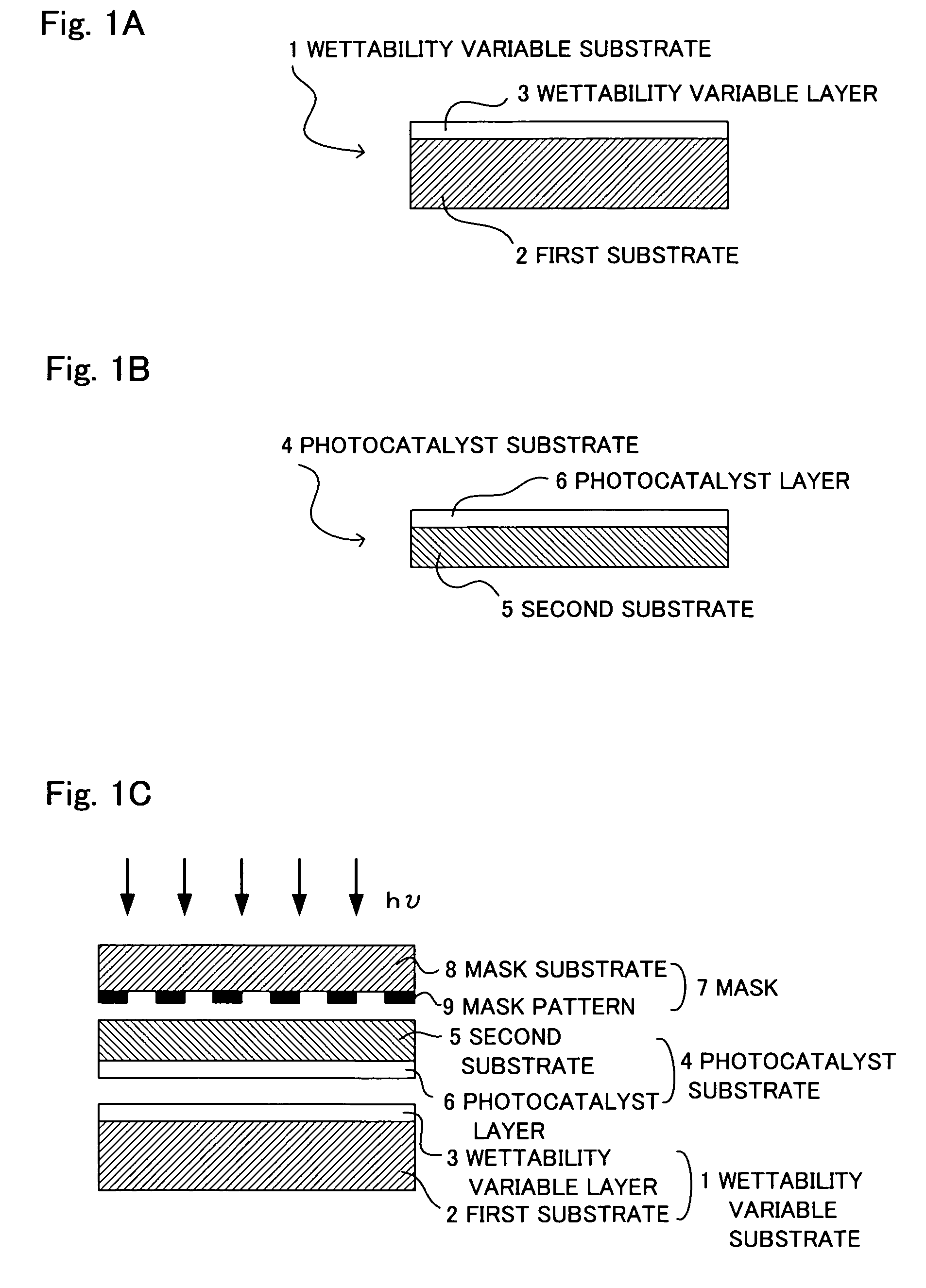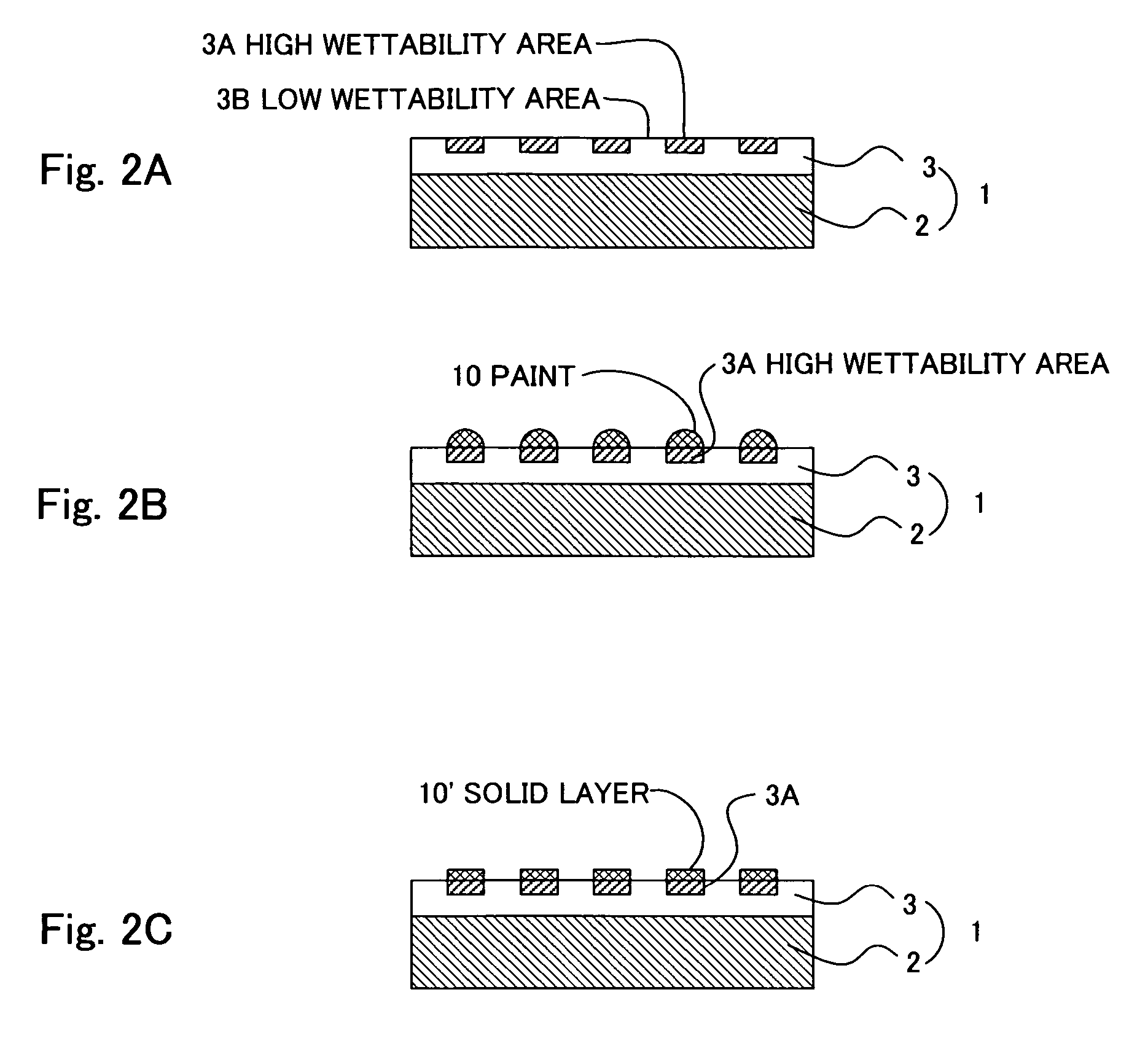Wettability variable substrate and wettability variable layer forming composition
- Summary
- Abstract
- Description
- Claims
- Application Information
AI Technical Summary
Benefits of technology
Problems solved by technology
Method used
Image
Examples
example 1
[0073]A solution consisting of 5 g of tetramethoxysilane (trade name: TSL8114, manufactured by GE Toshiba Silicones Co., Ltd.), 1.5 g of fluoroalkylsilane (trade name: TSL8223, manufactured byGEToshiba Silicones Co., Ltd.) and2.36g of 0.005NHCl (aqueous solution) was stirred at 20° C. for 24 hours. Then, the solution was diluted with isopropyl alcohol by 100 times (weight basis, same for the comparative examples) to obtain a wettability variable layer forming composition. Using this wettability variable layer forming composition, spine coated onto a glass substrate, and dried at 150° C. for 10 minutes to obtain a wettability variable substrate having a transparent and even wettability variable layer.
[0074]On the mask pattern side of a photomask, with a mask pattern of stripes of Cr thin layer having a width of 50 μm and a pitch of 100 μm formed on a glass substrate, a transparent photocatalyst layer was laminated by spin coating a water dispersion solution of titanium dioxide (trade...
example 2
[0075]A wettability pattern was formed in the same manner as in Example 1 except that the ratio of each component to be compounded was 0.59 g of tetramethoxysilane (trade name: TSL8114, manufactured by GE Toshiba Silicones Co., Ltd.), 5.91 g of fluoroalkylsilane (trade name: TSL8223, manufactured by GE Toshiba Silicones Co., Ltd.) and 2.36 g of 0.005N HCl (aqueous solution). The resulting wettability pattern had the characteristics that the contact angle of the unexposed part to water was 120° and the contact angle to a liquid having a surface tension of 40 mN / m was 89°, the contact angle of the exposed part to water was 10° or less, and took 230 seconds until the contact angle to a liquid having a surface tension of 40 mN / m became 9° or less. Also, the width of the unexposed part was 49 μm and the width of the exposed part was 51 μm.
example 3
[0076]A wettability pattern was formed in the same manner as in Example 1 except that the ratio of each component to be compounded was 6.19g of tetramethoxysilane (trade name: TSL8114, manufactured by GE Toshiba Silicones Co., Ltd.), 0.31 g of fluoroalkylsilane (trade name: TSL8223, manufactured by GE Toshiba Silicones Co., Ltd.) and 2.36 g of 0.005N HCl (aqueous solution). The resulting wettability pattern had the characteristics that the contact angle of the unexposed part to water was 105°, the contact angle to a liquid having a surface tension of 40 mN / m was 72°, the contact angle of the exposed part to water was 10° or less and took 90 seconds until the contact angle to a liquid having a surface tension of 40 mN / m became 9° or less. Also, the width of the unexposed part was 49 μm and the width of the exposed part was 51 μm.
PUM
| Property | Measurement | Unit |
|---|---|---|
| Force | aaaaa | aaaaa |
| Force | aaaaa | aaaaa |
| Angle | aaaaa | aaaaa |
Abstract
Description
Claims
Application Information
 Login to View More
Login to View More - R&D
- Intellectual Property
- Life Sciences
- Materials
- Tech Scout
- Unparalleled Data Quality
- Higher Quality Content
- 60% Fewer Hallucinations
Browse by: Latest US Patents, China's latest patents, Technical Efficacy Thesaurus, Application Domain, Technology Topic, Popular Technical Reports.
© 2025 PatSnap. All rights reserved.Legal|Privacy policy|Modern Slavery Act Transparency Statement|Sitemap|About US| Contact US: help@patsnap.com



